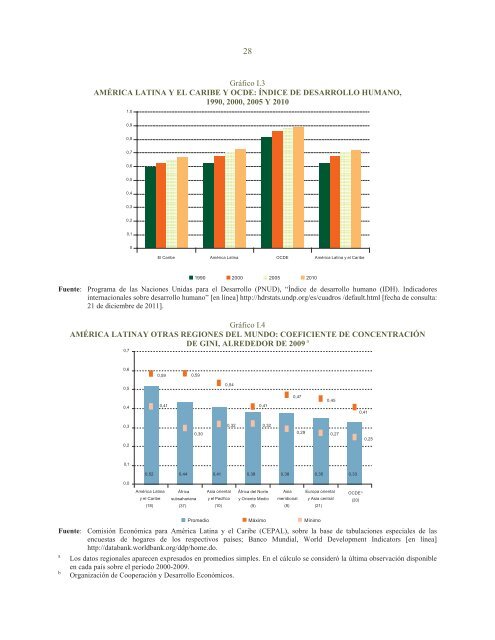La sostenibilidad del desarrollo a 20 años de la cumbre para la tierra: avances, brechas y lineamientos estratégicos para América Latina y el Caribe
En diciembre de 2009 la Asamblea General aprobó la resolución 64/236, en virtud de la cual decidió organizar la Conferencia de las Naciones Unidas sobre el Desarrollo Sostenible. Esta Conferencia se realizará en Río de Janeiro (Brasil) en junio de 2012, 20 años después de la Conferencia de las Naciones Unidas sobre el Medio Ambiente y el Desarrollo, conocida como Cumbre para la Tierra, y constituye una oportunidad histórica para hacer un balance de lo sucedido en estas dos décadas, evaluar los advances logrados y las dificultades encontradas y explorar nuevas formas de cooperación que permitan acelerar la transición hacia un desarrollo sostenible.
En diciembre de 2009 la Asamblea General aprobó la resolución 64/236, en virtud de la cual decidió organizar la Conferencia de las Naciones Unidas sobre el Desarrollo Sostenible. Esta Conferencia se realizará en Río de Janeiro (Brasil) en junio de 2012, 20 años después de la Conferencia de las Naciones Unidas sobre el Medio Ambiente y el Desarrollo, conocida como Cumbre para la Tierra, y constituye una oportunidad histórica para hacer un balance de lo sucedido en estas dos décadas, evaluar los advances logrados y las dificultades encontradas y explorar nuevas formas de cooperación que permitan acelerar la transición hacia un desarrollo sostenible.
Create successful ePaper yourself
Turn your PDF publications into a flip-book with our unique Google optimized e-Paper software.
28<br />
Gráfico I.3<br />
AMÉRICA LATINA Y EL CARIBE Y OCDE: ÍNDICE DE DESARROLLO HUMANO,<br />
1990, <strong>20</strong>00, <strong>20</strong>05 Y <strong>20</strong>10<br />
1,0<br />
0,9<br />
0,8<br />
0,7<br />
0,6<br />
0,5<br />
0,4<br />
0,3<br />
0,2<br />
0,1<br />
0<br />
El <strong>Caribe</strong> <strong>América</strong> <strong>La</strong>tina OCDE <strong>América</strong> <strong>La</strong>tina y <strong>el</strong> <strong>Caribe</strong><br />
Fuente: Programa <strong>de</strong> <strong>la</strong>s Naciones Unidas <strong>para</strong> <strong>el</strong> Desarrollo (PNUD), “Índice <strong>de</strong> <strong><strong>de</strong>sarrollo</strong> humano (IDH). Indicadores<br />
internacionales sobre <strong><strong>de</strong>sarrollo</strong> humano” [en línea] http://hdrstats.undp.org/es/cuadros /<strong>de</strong>fault.html [fecha <strong>de</strong> consulta:<br />
21 <strong>de</strong> diciembre <strong>de</strong> <strong>20</strong>11].<br />
Gráfico I.4<br />
AMÉRICA LATINAY OTRAS REGIONES DEL MUNDO: COEFICIENTE DE CONCENTRACIÓN<br />
DE GINI, ALREDEDOR DE <strong>20</strong>09 a<br />
0,7<br />
1990 <strong>20</strong>00 <strong>20</strong>05 <strong>20</strong>10<br />
0,6<br />
0,59 0,59<br />
0,5<br />
0,54<br />
0,4<br />
0,41<br />
0,41<br />
0,47<br />
0,45<br />
0,41<br />
0,3<br />
0,32 0,32<br />
0,2<br />
0,30<br />
0,29 0,27<br />
0,25<br />
0,1<br />
0,52 0,44 0,41 0,38 0,38 0,35 0,33<br />
0,0<br />
<strong>América</strong> <strong>La</strong>tina<br />
y <strong>el</strong> <strong>Caribe</strong><br />
(18)<br />
África<br />
subsahariana<br />
(37)<br />
Asia oriental<br />
y <strong>el</strong> Pacífico<br />
(10)<br />
África <strong><strong>de</strong>l</strong> Norte<br />
y Oriente Medio<br />
(9)<br />
Asia<br />
meridional<br />
(8)<br />
Europa oriental<br />
y Asia central<br />
(21)<br />
OCDE b<br />
(<strong>20</strong>)<br />
Promedio<br />
Fuente: Comisión Económica <strong>para</strong> <strong>América</strong> <strong>La</strong>tina y <strong>el</strong> <strong>Caribe</strong> (CEPAL), sobre <strong>la</strong> base <strong>de</strong> tabu<strong>la</strong>ciones especiales <strong>de</strong> <strong>la</strong>s<br />
encuestas <strong>de</strong> hogares <strong>de</strong> los respectivos países; Banco Mundial, World Dev<strong>el</strong>opment Indicators [en línea]<br />
http://databank.worldbank.org/ddp/home.do.<br />
a<br />
Los datos regionales aparecen expresados en promedios simples. En <strong>el</strong> cálculo se consi<strong>de</strong>ró <strong>la</strong> última observación disponible<br />
en cada país sobre <strong>el</strong> período <strong>20</strong>00-<strong>20</strong>09.<br />
b<br />
Organización <strong>de</strong> Cooperación y Desarrollo Económicos.<br />
Máximo<br />
Mínimo


















